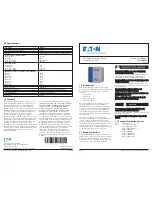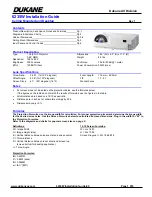
Setting Up
Place the projector on a firm table or
other support of convenient
height.
Set up the projection
screen. Be guided
as to the relative location of the pro-
jector and screen by the information
on
pages 13 and 14. Unlatch the cover
locks, tilt the cover away from the pro-
jector, and lift it off.
Lift the
SUPPLY REEL ARM
(Figure 1) up
as far as it will go. Lift up the
TAKE-UP
REEL ARM
until the
TAKE-UP
BELT
can be
put on the take-up pulley. Do not twist
the belts.
When projecting
film
on
50-
foot
(15.2
m)
or 100-foot
(30.5
m)
reels or film
on
reels with cores smaller
than
two
inches in-diameter,
remove
the
belt from the supply pulley.
With
these smaller reels, allow the belt to
rest between the pulley and the arm.
The belt should be replaced on the
pulley when the projector
is run in
reverse or when film is being rewound.
Be sure the diameter of the take-up
reel is at least equal to the diameter
of the supply reel.
Remove the
POWER CORD
from its stor-
age space. This projector
is equipped
with a 3-wire power cord and a 3-prong
polarized plug for direct connection to
a 105- to 12S-volt, 60 Hz wall recep-
4
tacle of the grounding
type. By using a
suitable power cord adapter, it is pos-
sible to plug into a conventional
wall
receptacle. When you do this, connect
the grounding wire attached to the
2-prong adapter to a suitable ground.
For convenience
it is suggested that-
in those locations where the projector
will be used frequently-the
usual
2-prong receptacle be replaced with a
3-prong polarized receptacle,
properly
grounded.
If an extension power cord is used, be
sure that it has adequate current-carry-
ing capacity (No. 18 AWG wire or larger)
to avoid overheating
the cord and that
it is as short as possible to prevent
excessive voltage drop.
Position the speaker as close to the
screen as possible. Uncoil enough
speaker cable to connect the plug to
the
SPEAKER JACK
(Figure 1) in the
amplifier.
The speaker should be placed
at the ear level of the audience for
proper sound distribution.
A phone extension cable can be used
for a speaker extension cord, providing
it is No. 18 AWG wire or larger and has
a
V4
-inch phone plug and line recep-
tacle at the ends.
CAUTION:
A short in the cord or
plugs might damage the amplifier.
Make sure that the
REWIND TAB
is in the
position shown in Figure 1. Turn on
the
PROJECTOR POWER SWITCH.
Then,
turn on the motor and lamp by moving
the
MASTER CONTROL
all the way forward
to the front of the projector.
Rotate
the lens clockwise or counterclockwise
until the margins of the lighted area on
the screen are in focus.
Adjust the elevation by turning the
ELEVATION CONTROL
clockwise until the
lighted area is centered on the screen.
While the projector
is running forward,
move the
SPEED SELECTOR
to SILENT or
SOUND, depending
upon the film being
projected. To move the selector from
SOUND to SILENT, push the lever to the
left as far as it will go; to go from
SILENTto
SOUND, push the selector
upward to release it-the
selector will
automatically
move to the SOUND
position.
Turn off the projection
lamp and the
motor. Turn the
VOLUME CONTROL
fully
counterclockwise
and the
TONE CONTROL
to NORMAL.
Make sure that the
SOUND-INPUT
SWITCH
is at the FILM position.
•





































